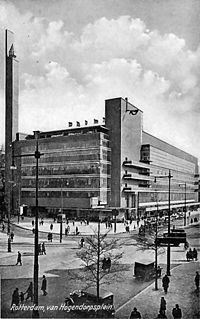- De Bijenkorf (Rotterdam)
-
Coordinates: 51°55′13″N 4°28′44″E / 51.92028°N 4.47889°E
The Rotterdam branch of De Bijenkorf is one of the three main branches of the department store. The present building dates from 1956 and is the symbol of the rebuilding of the city of Rotterdam . It is in Amsterdam and The Hague is one of the three "flagship stores", major chain stores. For a long time the only stores were in Amsterdam, The Hague and Rotterdam. A fourth location, Eindhoven was opened in 1969, the first outside the Randstad.
The building stands prominently in front of Beurs-World Trade Center on the Coolsingel. Its predecessor was opened in 1930 and stood at the Van High Village Square (now the Churchill Square), on the corner with current Blaak and was designed by architect Willem Dudok. The ground work began in 1929 and the first pile was beaten on June 13 of that year. The opening on 16 October 1930 was an event that attracted 70,000 people.
During the Rotterdam Blitz of 14 May 1940 the building was largely destroyed. The part that had been preserved (about one third) was, till the opening of the new building in 1956, used as a warehouse, for three years after this it was used as storage. In 1960, on the orders of the municipality it was demolished in connection with the construction of the Westblaak and the subway to the south of Rotterdam .
The new, current Beehive rose a little further to the Coolsingel and was designed by the Hungarian-American architect Marcel Breuer.
First escalator
The Dudok's building was, before the war, the first building in Rotterdam that had escalators and an electric mat to automatically sweep of the shoe.
See also
- De Bijenkorf (Amsterdam)
- De Bijenkorf (The Hague)
External links
Categories:- Rijksmonuments in Rotterdam
- Department stores of the Netherlands
Wikimedia Foundation. 2010.


